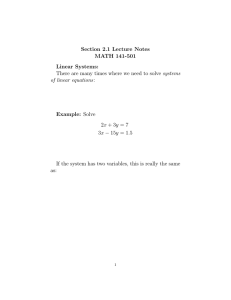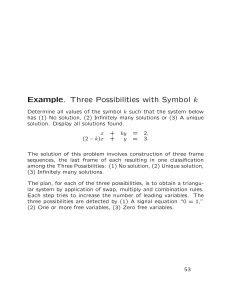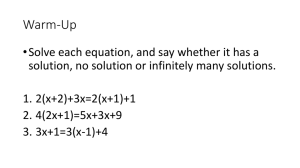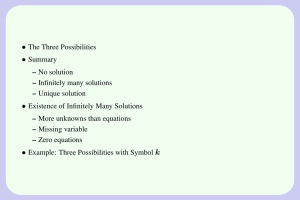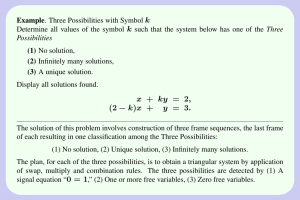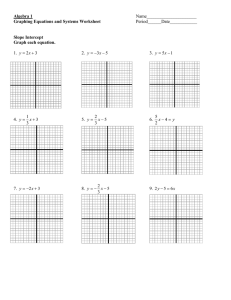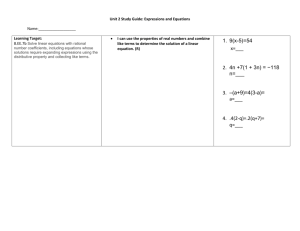•
advertisement
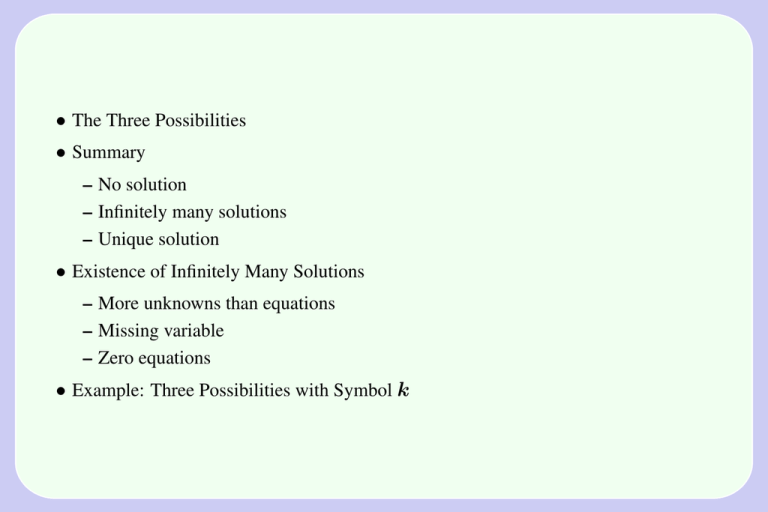
• The Three Possibilities • Summary – No solution – Infinitely many solutions – Unique solution • Existence of Infinitely Many Solutions – More unknowns than equations – Missing variable – Zero equations • Example: Three Possibilities with Symbol k The Three Possibilities The three possibilities for a linear system, in terms of free variables, rank and nullity, are summarized as follows. Table 1. Three possibilities for a linear system. No solution Signal equation 0 = 1 Infinitely many solutions One or more free variables nullity ≥ 1 Unique solution Zero free variables nullity = 0 Summary • No Solution. There is no solution to a system of equations exactly when a signal equation 0 = 1 occurs during the application of swap, multiply and combination rules. We report the system inconsistent and announce no solution. • Infinitely Many Solutions. The situation of infinitely many solutions occurs when there is at least one free variable to which an invented symbol, say t1 , is assigned. Since this symbol takes the values −∞ < t1 < ∞, there are an infinity of solutions. The condition rank less than n can replace a reference to the number of free variables. • Unique Solution. There is a unique solution to a system of equations exactly when zero free variables are present. This is identical to requiring that the number n of variables equal the number of lead variables, or rank = n. Existence of Infinitely Many Solutions Homogeneous systems are always consistent, therefore if the number of variables exceeds the number of equations, then there is always one free variable. This proves the following basic result of linear algebra. Theorem 1 (Infinitely Many Solutions) A system of m × n linear homogeneous equations with fewer equations than unknowns (m < n) has at least one free variable, hence an infinite number of solutions. Therefore, such a system always has the zero solution and also a nonzero solution. Theorem 2 (Missing Variable) A system of m × n linear homogeneous equations with one unknown missing has at least one free variable, hence an infinite number of solutions. Therefore, such a system always has the zero solution and also a nonzero solution. Theorem 3 (Zero Equations) If a system of m × n linear homogeneous equations contains a zero equation 0 = 0, then the system need not have infinitely many solutions. It can have infinitely many solutions or a unique solution! 1 Example (Three Possibilities with Symbol k) Determine all values of the symbol k such that the system below has one of the Three Possibilities (1) No solution, (2) Infinitely many solutions or (3) A unique solution. Display all solutions found. x + ky = 2, (2 − k)x + y = 3. Solution The Three Possibilities are detected by (1) A signal equation “0 = 1,” (2) One or more free variables, (3) Zero free variables. The solution of this problem involves construction of perhaps three frame sequences, the last frame of each resulting in one of the three possibilities (1), (2), (3). x + (2 − k)x + x + x + ky = y = 2, 3. ky = 2, [1 + k(k − 2)]y = 2(k − 2) + 3. ky = (k − 1)2y = 2, 2k − 1. Frame 1. Original system. Frame 2. combo(1,2,k-2) Frame 3. Simplify. The three expected frame sequences share these initial frames. At this point, we identify the values of k that split off into the three possibilities. • There will be a signal equation if the second equation of Frame 3 has no variables, but the resulting equation is not “0 = 0.” This happens exactly for k = 1. The resulting signal equation is “0 = 1.” We conclude that one of the three frame sequences terminates with the no solution case. This frame sequence corresponds to k = 1. • Otherwise, k 6= 1. For these values of k, there are zero free variables, which implies a unique solution. A by-product of the analysis is that the infinitely many solutions case never occurs! • The conclusion: The initially expected three frame sequences reduce to two frame sequences. One sequence gives no solution and the other sequence gives a unique solution. The three answers: (1) No solution occurs only for k = 1. (2) Infinitely many solutions occurs for no value of k. (3) A unique solution occurs for k 6= 1. x=2− k(2k − 1) (k − 1)2 (2k − 1) y= . (k − 1)2 ,

